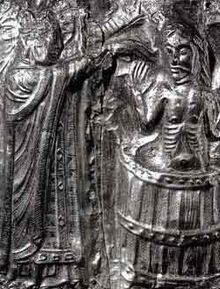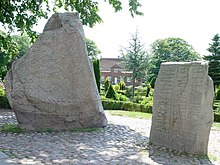Harald Bluetooth
This article needs additional citations for verification. (October 2008) |

Harald Bluetooth Gormson ([Haraldr Blátönn] Error: {{Lang-xx}}: text has italic markup (help), Danish: Harald Blåtand) (born c. 935) was the son of King Gorm the Old and of Thyra Dannebod. He died in 985 or 986 having ruled as King of Denmark from around 958 and king of Norway for a few years probably around 970. Some sources state that his son Sweyn forcibly deposed him as king.
The Jelling stones
Harald Bluetooth caused the Jelling stones to be erected to honour his parents.[1] Encyclopedia Britannica (Britannica) considers the runic inscriptions as the most well known in Denmark.[2] The biography of Harald Bluetooth is summed up by this runic inscription from the Jelling stones:
"Harald, king, bade these memorials to be made after Gorm, his father, and Thyra, his mother. The Harald who won the whole of Denmark and Norway and turned the Danes to Christianity."
Conversion and Christianisation of Denmark


The conversion of the Danes or, rather, the conversion of King Harald Bluetooth, is a contested bit of history, not least because medieval writers such as Widukind of Corvey and Adam of Bremen give conflicting accounts of how it came about.
We know from the runestone erected at Jelling Monument that Harald claimed to have converted the Danes himself. In his "History of the Archbishops of Hamburg-Bremen," finished in 1076, Adam of Bremen claimed that Harald was himself forcibly converted by Otto I, after a defeat in battle.[3] In the Icelandic saga about the Kings of Norway called the Heimskringla, this story was changed somewhat to have Harald be converted, along with Earl Hakon, by Otto II.
However, Widukind of Corvey, writing nearly 100 years before Adam and during the lives of Otto I and Harald, mentioned no such episode in his Res gestae saxonicae sive annalium libri tres or "Deeds of the Saxons". Considering that this history was at least partly written to promote the greatness of Otto and his family, this silence is damning to Adam of Bremen's claim. Widukind himself claims that Harald was converted by a "cleric by the name of Poppa" who, when asked by Harald whether he would be tested as to his faith in Christ, supposedly carried "a great weight of iron" heated by a fire without being burned.[4] A similar story does appear in Adam of Bremen's history, but about Eric of Sweden, who had supposedly conquered Denmark (there is no evidence that this happened anywhere else), and a self-immolating cleric named Poppo.[5] The story of this otherwise unknown Poppo or Poppa's miracle and baptism of Harald is also depicted on the gilded altar piece in the Church of Tandrup in Denmark, a detail of which is at the top of this article. The altar itself has been dated to about 1200.[6] Adam of Bremen's claim regarding Otto I and Harald appears to have been inspired by an attempt to manufacture a historical reason for the archbishops of Hamburg-Bremen to claim jurisdiction over Denmark (and thus the rest of Scandinavia); in the 1070s, the Danish King was in Rome asking for Denmark to have its own arch-bishop, and Adam's account of Harald's supposed conversion (and baptism of both him and his "little son" Sweyn, with Otto serving as Sweyn's godfather) is followed by the unambiguous claim that "At that time Denmark on this side of the sea, which is called Jutland by the inhabitants, was divided into three dioceses and subjected to the bishopric of Hamburg."[3]
As noted above, Harald's father, Gorm the Old had died in 958, and he had been buried in a mound with many grave goods, after the pagan practice. The mound was itself from c. 500 BCE, but Harald had it built higher over his father's grave, and added a second mound to the south. Mound-building was a newly revived custom in the tenth century, possibly as a "self-conscious appeal to old traditions in the face of Christian customs spreading from Denmark's southern neighbors, the Germans."[7]
But after his conversion, in about the 960s, Harald had his father's body disinterred and reburied in the church he built next to the now empty mound, and erected the now famous Jelling stones described above.

Harald undoubtedly professed Christianity at that time; it is also true that he contributed to its spread.[8]
Reign
During his reign, Harald oversaw the reconstruction not only of the Jelling runic stones but of other projects as well. Some believe that these projects were a way for him to preserve the economic and military control of his country. During that time, ring forts were built in five strategic locations: Trelleborg on Sjælland, Nonnebakken on Fyn, Fyrkat in central Jylland, Aggersborg near Limfjord, and Trelleborg near the city of Trelleborg in Scania in present-day Sweden. All five fortresses had similar designs: "perfectly circular with gates opening to the four corners of the earth, and a courtyard divided into four areas which held large houses set in a square pattern."[9] A sixth Trelleborg is located in Borgeby, in Scania in present-day Sweden. This one has been dated to the vicinity of 1000 AD and has a similar design, so it too may have been built by king Harald.

He also constructed the oldest known bridge in southern Scandinavia, known as the Ravninge Bridge in Ravninge meadows, which was 5m wide and 760m long.
While absolute quiet prevailed throughout the interior, he was even able to turn his thoughts to foreign enterprises. Again and again he came to the help of Richard the Fearless of Normandy (in the years 945 and 963), while his son conquered Samland and, after the assassination of King Harald Graafeld of Norway, he also managed to force the people of that country into temporary subjection to himself.
The Norse sagas presents Harald in a rather negative light. He was forced twice to submit to the renegade Swedish prince Styrbjörn the Strong of the Jomsvikings- first by giving Styrbjörn a fleet and his daughter Tyra, the second time by giving up himself as hostage and an additional fleet. Styrbjörn brought this fleet to Uppsala in Sweden in order to claim the throne of Sweden. However, this time Harald broke his oath and fled with his Danes in order to avoid facing the Swedish army at the Battle of the Fýrisvellir.
As a consequence of Harald's army having lost to the Germans in the shadow of Danevirke in 974, he no longer had control of Norway and Germans having settled back into the border area between Scandinavia and Germany. The German settlers were driven out of Denmark in 983 by an alliance consisting of Obodrite soldiers and troops loyal to Harald. Soon after, Harald was killed fighting off a rebellion led by his son Sweyn. He was believed to have died in 986, although there are many other accounts that claim he died in 985.
Marriages and issue
- Gyrid Olafsdottir, probably by 950.
- Thyra Haraldsdotter, married Styrbjörn Starki
- Sveyn Forkbeard. Born about 960. Usually given as the son of Harald and Gyrid, though it is said in some of the older sagas that he was an illegitimate son.
- Hakon. Born in 961.
- Gunhilde. She married Pallig, Jarl and Ealdorman in Devon. They both died in the St. Brice's Day massacre in November 1002.
- Thora (Tova) the daughter of Mistivir in 970. She raised the Sønder Vissing Runestone after her mother.
Pop culture
- From 1835 to 1977 it was believed that Harald ordered the death of Haraldskær Woman, a bog body thought to be Gunnhild, Mother of Kings until radiocarbon dating proved otherwise.[10]
- The old-time radio show "Vic and Sade," written by Paul Rhymer in the 1930s to 1950s, sometimes made mention of "Bluetooth Johnson," a teenage friend of main character Rush Gook. This character presumably was so named in oblique reference to Bluetooth Gormson.
- "Bluetooth" now more commonly refers to the Bluetooth wireless specification designed to enable cable-free connections between computers, mobile phones, PDAs, printers, etc. Bluetooth in these devices is named after this king. The Bluetooth logo consists of the Nordic runes for his initials, H and B (Long-branch runes version). Harald is regarded as having united (if temporarily) Denmark, Norway, and Sweden under a single king.[11]
In literature
- Ancestral Roots of Certain American Colonists Who Came to America Before 1700, by Frederick Lewis Weis, Lines 1B–22 & 243A–20
- Poul Anderson's "The Mother of the Kings" is mainly concerned with the Norwegian King Erik Bloodaxe and his family, but a section takes place in Denmark, with a depiction of the young and ambitious Harald Bluetooth ruthlessly playing off various factions and Viking leaders against each other.
- In The Long Ships or Red Orm (original title: Röde Orm), a best-selling Swedish novel written by Frans Gunnar Bengtsson, the plot takes place some decades later - a large part of it in the court of the aging Harald, shortly before the outbreak of the rebellion of his son Swen. (One of the characters, a Christian cleric, makes comparisons with the Biblical story of King David and his son Absalom).
References
- ^ [1]C. Michael Hogan, "Jelling Stones", Megalithic Portal, editor Andy Burnham
- ^ [2] Encyclopedia Brittanica
- ^ a b Adam of Bremen, History of the Archbishops of Hamburg-Bremen, trans. Francis J. Tschan (New York, 2002), 55–57.
- ^ Widukind, Res gestae Saxonicae 3.65, ed. Paul Hirsch and Hans-Eberhard Lohmann, MGH SS rer. Germ. in usum scholarum (Hanover, 1935), 140–141. Translated from the Latin by Anders Winroth, © 2006.
- ^ Adam of Bremen, History of the Archbishops of Hamburg-Bremen, trans. Francis J. Tschan (New York, 2002), 77–78.
- ^ Anders Winroth, Viking Sources in Translation, 2009.
- ^ Anders Winroth, Viking Sources in Translation, in text drawing on a caption by Anders Winroth in Barbara Rosenwein, Reading the Middle Ages, p. 266. (Peterborough, Ont., 2006).
- ^ "A History of Christianity", by Kenneth S. Latourette
- ^ Fortehad, Oram and Pedersen, Viking Empires, Cambridge University Press (2005) ISBN 0-521-82992-5, pg. 180
- ^ "Haraldskaer Woman: Bodies of the Bogs", Archaeology, Archaeological Institute of America, December 10, 1997
- ^ Bluetooth, About the Bluetooth SIG.
External links
- This article incorporates text from the 1913 Catholic Encyclopedia article "Harold Bluetooth" by Pius Wittmann, a publication now in the public domain.
- Northvegr (Scandinavian) - A History of the Vikings (Search)
- Vikingworld (Danish) - King Harald Bluetooth (Harald Blåtand)
- Vikingworld (Danish) - Christening of the Danes

